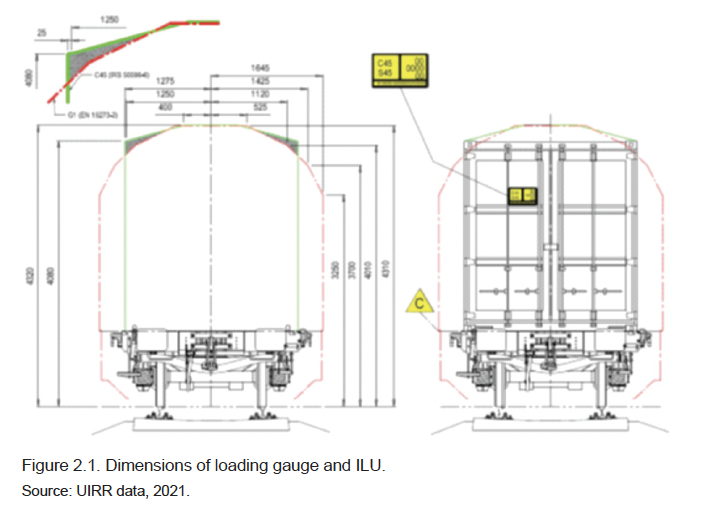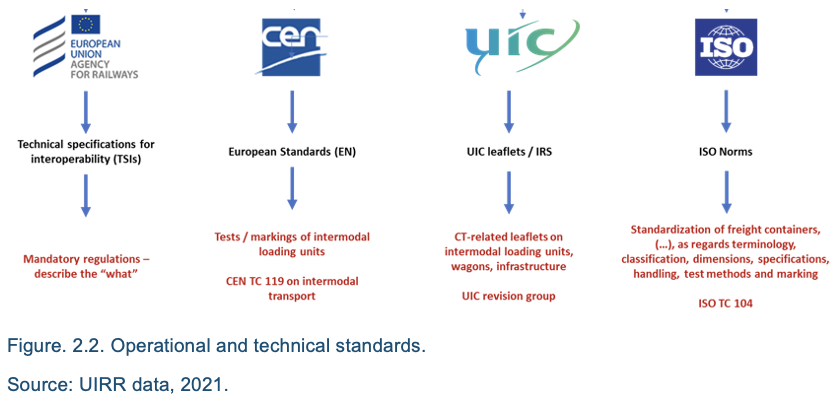2.1.1. Codification system
CT deals with the conveyance of ILUs by road, rail, inland waterways, and short sea shipping. The dimensions of most ILUs (i.e., semi-trailers, swap bodies, and roller units) are optimized for road transport and, when they are forwarded on wagons, in a relevant number of cases, their upper sections may exceed the standard loading gauge in terms of height in several European Member States. The most common solution in this case is to use and apply the procedures for exceptional consignments according to UIC Leaflet 502-1. The nature of this procedure is cumbersome as it obliges the railway undertakings to obtain specific authorization from all the involved infrastructure managers and to check the size of the ILUs when loaded on the wagons to ensure that they do not exceed authorized dimensions.
The codification system as per International Railway Solution (IRS)–IRS 50596-6 was established by UIC in collaboration with UIRR to facilitate and speed up the conveyance of ILUs in a reliable manner, even when their upper dimensions exceed those compatible with the loading gauge of the line (Figure 2.1).
The codification system as defined in IRS 50596-6 has been applied for several decades by various RUs and IMs in the CT chain and ensures safe operations of ILUs loaded on compatible wagons when transported on codified routes lines. IRS 50596-6 provides the system requirements for the allocation of the compatibility code and the correction digits to the wagons, the codification of the ILUs, the codification of the lines, the verification of the compatibility between ILU’s and carrier wagons, and the assessment of the compatibility between ILU’s conveyed on suitable wagons and the lines.
2.1.2. Interoperability Directive and TSIs
Between 2001 and 2016, four legislative packages (known as “railway package”) were adopted with the aim of gradually opening up rail transport service markets

for competition, making national railway systems interoperable and defining appropriate framework conditions for the development of a single European railway area. These include charging and capacity allocation rules, common provisions on licensing of railway undertakings and train driver certification, safety and interoperability requirements, the creation of the European Agency for railways, and rail regulatory bodies in each Member State as well as rail passenger rights.
Interoperability aims at the suitability of the trans-European safe rail system and continuous train service. This suitability is based on the entire regulatory, technical, and operational conditions to meet the essential requirements from the interoperability guidelines. The Interoperability Directive (i.e., revised and adopted in the context of the fourth railway package in 2015) aims to overcome the historic, peace meal creation of national railway systems with their diverse solutions to similar problems.
In the context of the railway packages, the railway Interoperability Directive 2008/57/EC of 17 June 2008 sets out the conditions to be met to achieve interoperability within the Union rail system. The Technical Specifications for Interoperability (TSI) define the technical and operational standards which must be met by each subsystem or part of subsystem in order to meet the essential requirements and ensure the interoperability of the railway system of the European Union. More than 11 TSIs have been adopted and are regularly reviewed under the coordination of the European Union Agency for Railways. The most relevant for CT operations are:
- Freight wagon concerns the rolling stock subsystem and applies to freight wagons including vehicles designed to carry lorries;
- Noise TSI sets out the optimal level of harmonization related to specifications on the rolling stock subsystem intended to limit the noise emission of the railway system of the EU;
- Operation and traffic management TSI applying to the operation and traffic management subsystem of infrastructure managers and railway undertakings related to the operation of trains on the rail system of the EU; and
- Telematics applications for freight services TSI applying to applications for freight services, including information systems, marshalling and allocation systems, reservation, payment and invoicing systems, management of connections with other modes of transport and production of electronic accompanying documents.
2.1.3. Weights and dimensions
In Europe, heavy goods vehicles, buses, and coaches must comply with certain rules on weights and dimensions for road safety reasons and to avoid damaging roads, bridges, and tunnels. Directive (EU) 2015/719 sets maximum dimensions and weights for international traffic, also ensuring that Member States cannot restrict the circulation of vehicles which comply with these limits from performing international transport operations within their territories. The Directive also aims at avoiding that national operators benefit from undue advantages over their competitors from other Member States when performing national transport. These rules are complemented by the requirements for type-approval of commercial vehicles laid out in Regulation 2018/858 which sets the framework for putting vehicles such as light-duty and heavy-duty vehicles, buses, and trailers on the market (Table 2.1).
The two legal documents include some CT-specific components:
- The maximum admissible mass for road and intermodal operations as specified in Annex 1 (see summary table);
- The maximum length may be exceeded by 15 cm for vehicles or vehicle combinations engaged in the transport of 45-foot containers or 45-foot swap bodies, empty or loaded, when integrated in an intermodal operation; and
- The use of aerodynamic devices shall be compatible with intermodal transport operations and in particular when retracted/folder they shall not exceed the maximum authorized length by more than 20 cm. The detailed technical requirements for intermodal are set in the Regulation 2018/858.
Table 2.1. Vehicle combinations.

2.1.4 General terms and conditions
To facilitate the operations in CT, general terms and conditions should govern the relationship between a CT operator and its customer (i.e., entity which gives the order to transport the unit). This document should define the rights, obligation, and liabilities of each party, the effects on the contract conclusion and its end, special clauses for specific types of products (such as dangerous goods), the payment conditions, and the terms of indemnity.S
2.1.5 Standardization
The stakeholders involved in the CT have to deal with several operational and technical standards (i.e., TSIs, EN, UIC IRS, and ISO) that (1) define the design and testing requirements for the ILUs and of their constituents, and (2) fix the condition for the operational compatibility of the ILUs with the means used for their conveyance in the different transport modes (i.e., trucks, wagons, and ships) and in the terminals for their transshipment (Figure 2.2).

CEN, the European Committee for Standardization, is an association that brings together the national standardization bodies of 34 European countries. It is one of three European standardization organizations (i.e., together with CENELEC and ETSI) that has been officially recognized by the EU and the European Free Trade Association as being responsible for developing and defining voluntary standards at European level. The CEN Technical Committee 119 (i.e., ILUs and cargo securing) is responsible for all European standards related to the ILUs designed for intermodal transport and for test methods for cargo securing (i.e., 20 standards in total). For operations, the most relevant EN standard is the EN 13044 for the markings to be used in CT operations:
- Part 1 of the standard defines the structure of the ILU identification code (i.e., 4 digits for the owner, 6 digits for the unit registration, and 1 digit for the control digit) known as the ILU-Code. UIRR is officially the Administrator of the ILU-Code since July 2011. More than 1,000 owner-keys have been reserved and all relevant information can be found under www.ilu-code.eu (Table 2.2).
- Part 2 and 3 define the codification plates necessary for the swap bodies and semi-trailers. These operational markings are essential for train departure controls in order to ensure compatibility between ILUs, wagons, and selected lines.

ISO, International Organization for Standardization, is an independent, non-governmental international organization with a membership of 165 national standards bodies. Through its members, it brings together experts to share knowledge and develop voluntary, consensus-based, market relevant international standards that support innovation and provide solutions to global challenges. The ISO standards are classified according to an international coding system that is published in the International Classification for Standards. All activities are performed in Technical Committees (TCs). The ISO/TC 104 (i.e., freight containers) deal with the standardization of freight containers having an external volume of one cubic meter (35.3 cubic feet) and greater, as regards terminology, classification, dimensions, specifications, handling, test methods, and marking. The ISO/TC 104 is structured in 3 sub-committees responsible for more than 40 ISO standards.
UIC, Union Internationale des Chemins de Fer, the worldwide professional association representing the railway sector and promoting rail transport prepares and maintains the IRS which blends together a range of voluntary solutions to support the design, construction, operation, and maintenance of the railway system and the services that the sector provides. The UIC Expert Group for freight related Items (SET 03) is responsible for the maintenance and review cycles of all relevant technical and operational specificities of CT (lines, intermodal loading units, wagons, and loading guidelines).